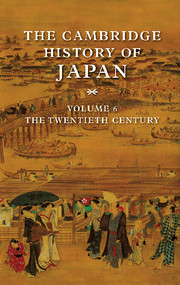Book contents
- Frontmatter
- 1 Introduction
- PART I DOMESTIC POLITICS
- PART II EXTERNAL RELATIONS
- PART III ECONOMIC DEVELOPMENT
- Part IV SOCIAL AND INTELLECTUAL CHANGE
- 11 The transformation of rural society, 1900–1950
- 12 Economic development, labor markets, and industrial relations in Japan, 1905–1955
- 13 Socialism, liberalism, and Marxism, 1901–1931
- 14 Japanese revolt against the West: political and cultural criticism in the twentieth century
- Works Cited
- Index
- References
13 - Socialism, liberalism, and Marxism, 1901–1931
from Part IV - SOCIAL AND INTELLECTUAL CHANGE
Published online by Cambridge University Press: 28 March 2008
- Frontmatter
- 1 Introduction
- PART I DOMESTIC POLITICS
- PART II EXTERNAL RELATIONS
- PART III ECONOMIC DEVELOPMENT
- Part IV SOCIAL AND INTELLECTUAL CHANGE
- 11 The transformation of rural society, 1900–1950
- 12 Economic development, labor markets, and industrial relations in Japan, 1905–1955
- 13 Socialism, liberalism, and Marxism, 1901–1931
- 14 Japanese revolt against the West: political and cultural criticism in the twentieth century
- Works Cited
- Index
- References
Summary
In the 1890s many observers at home and abroad discovered that Japan had finally entered the mainstream of world history and had indeed become a principal actor in that history. As Ōkuma Shigenobu remarked at the end of the Sino-Japanese War, “Japan is no longer a Japan for Japan, but a Japan for the world.” Although some Japanese viewed the end of their cultural and political isolation as cause for unrestrained self-congratulation, others were ambivalent about its implication for the future. If Japan became more like other modern nations, its material and political development might continue, but only at the expense of social harmony or cultural integrity. As the country moved into a new century, there was uncertainty over the shape of Japan's future.
One vision of the future saw Japan as eternally unique, able to maintain its traditional culture and values even in the midst of rapid economic and political change. This point of view, which we might call the particularist or exceptionalist perspective, found champions in the Seikyōsha writers of the early 1890s, who urged that the nation's cultural essence (kokusui) be preserved in the march toward modernity. Given the polychromatic character of Japan's cultural past, however, it was difficult to identify this cultural essence. Unlike China, which boasted of an easily identifiable great tradition, Japan had none. Where, then, were the Seikyōsha writers to find the kokusui–in the myths and legends of the Shinto tradition, in the sensibilities of Heian culture, in the harsh ethos of the warrior class, in the boisterous arts of the Tokugawa townsmen, or in the austere puritanism of Tokugawa Confucianism?
- Type
- Chapter
- Information
- The Cambridge History of Japan , pp. 654 - 710Publisher: Cambridge University PressPrint publication year: 1989
References
- 2
- Cited by



